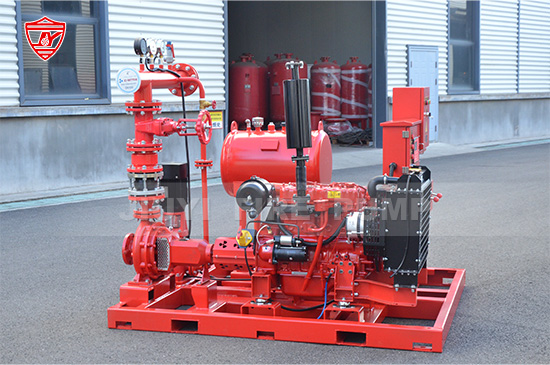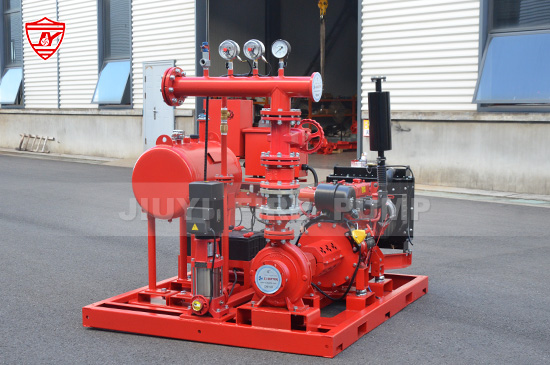In modern fire protection systems, reliability and real-time monitoring are essential. Fire pumps are the backbone of a building’s fire protection infrastructure—responsible for ensuring that the required water pressure and flow are always available during emergencies. Traditionally, routine manual inspections were the only way to ensure the pumps’ performance. However, with the advancement of smart technologies and Internet of Things (IoT) systems, remote fire pump monitoring has become a game-changer in maintaining safety, efficiency, and compliance.
This article explores how to monitor fire pump performance remotely, the technologies involved, key parameters to track, and the benefits it brings to facility managers and fire protection engineers.

Fire pumps are mission-critical assets. If a failure occurs at the wrong time, the results could be catastrophic. NFPA 20 requires that fire pumps remain in standby mode 24/7, ready for immediate operation. Traditionally, maintenance personnel rely on manual checks and periodic tests to verify functionality. Yet, this approach often leaves long periods where potential issues could go unnoticed.
Remote monitoring eliminates these blind spots. By integrating sensors, data loggers, and cloud-based control systems, facility managers can continuously observe fire pump operation in real time, receiving alerts for abnormal conditions before they escalate into costly failures.
In addition, modern monitoring systems provide detailed historical data, enabling predictive maintenance and improved compliance reporting—critical for meeting fire safety standards and insurance requirements.
A well-designed remote monitoring setup integrates several elements that work together to provide accurate, real-time data. These components include:
Sensors collect data from various points in the fire pump system. Common sensors include:
Pressure sensors: Track suction and discharge pressures.
Flow sensors: Measure the actual water flow rate.
Temperature sensors: Detect overheating in the motor or bearings.
Vibration sensors: Monitor mechanical imbalance or wear.
Voltage and current sensors: Supervise electrical input and motor health.
The controller acts as the system’s brain, collecting and processing sensor data. Modern fire pump controllers often come with built-in monitoring interfaces compatible with remote systems. Data loggers store the readings and transmit them securely to a cloud or local server for real-time visualization.
Using wired Ethernet, Wi-Fi, or cellular networks (4G/5G), these modules transmit live data to centralized dashboards or mobile apps. In facilities where internet connectivity is unreliable, cellular gateways are commonly used for consistent data transfer.
This platform displays real-time information and analytics, allowing users to check system performance from anywhere. It can also send alerts through SMS, email, or push notifications when any parameter goes beyond the preset threshold.
Remote fire pump monitoring systems can track a wide range of data points. Key performance indicators (KPIs) that are most valuable include:
Pump Start/Stop Events: To confirm that automatic starting and stopping occurs as designed.
System Pressure Trends: Continuous monitoring ensures the pump maintains required discharge pressure.
Flow Rate Data: Helps confirm if the pump is delivering sufficient water for firefighting demands.
Power Supply Health: Monitoring voltage, current, and phase imbalance prevents electrical failures.
Running Hours: Useful for maintenance scheduling and wear assessment.
Alarm and Fault Logs: Automatically record any abnormal events, including low suction pressure, motor overload, or controller faults.
Temperature and Vibration Levels: Detect early signs of mechanical or motor-related issues.
Tracking these parameters helps predict failures before they occur and ensures that your fire pump is always ready for emergencies.
IoT (Internet of Things) technology has revolutionized fire pump monitoring. With IoT integration, data from multiple sensors is collected and analyzed in real time across multiple sites. Facility managers can access dashboards from their computer or smartphone to check status updates instantly.
Smart fire pump systems can even use machine learning algorithms to analyze performance trends and recommend proactive maintenance actions. For example, if the system detects gradual pressure loss or unusual vibration patterns, it can alert the maintenance team long before the pump fails.
Moreover, IoT-based systems allow multiple pumps and facilities to be connected on one platform, making it ideal for organizations managing multiple properties—such as industrial plants, shopping malls, and residential complexes.
Continuous monitoring ensures the fire pump will function correctly during an emergency. Any deviations from normal operation trigger instant alerts, reducing the risk of failure.
Remote monitoring enables predictive maintenance rather than reactive repairs. By identifying issues early—such as bearing wear, leaks, or motor overload—you can address them before they become costly failures.
Systems designed according to NFPA 20 and NFPA 25 can automatically log test results and operational data, simplifying compliance documentation. Historical reports can be easily retrieved during audits.
When abnormal conditions are detected—such as low suction pressure or power loss—the system sends immediate notifications to the responsible personnel. This enables faster response and minimizes damage risk.
Through a single dashboard, operators can manage multiple fire pump systems across various facilities. This centralization reduces manual inspections and increases operational efficiency.
To implement an effective remote monitoring system for fire pumps, follow these steps:
Assess Current System Setup:
Review the existing fire pump configuration, including control panels, sensors, and communication infrastructure.
Select Compatible Sensors and Controllers:
Choose sensors that meet fire protection standards and are compatible with your control panel.
Install Communication Modules:
Set up data transmission using cellular, Wi-Fi, or Ethernet modules to ensure stable connectivity.
Integrate with Cloud or Monitoring Software:
Configure a secure platform where you can visualize data, set alarm thresholds, and generate performance reports.
Test and Validate:
Conduct test runs to verify data accuracy and alert functionality. Ensure all emergency scenarios are properly captured by the monitoring system.
Train Personnel:
Equip facility managers and maintenance teams with training to interpret data and respond effectively to system alerts.
In areas with weak network signals, use cellular gateways or redundant communication paths to maintain data transmission.
Not all legacy fire pump controllers support IoT features. To overcome this, use compatible data loggers or retrofit modules that can collect analog signals and convert them into digital data.
Since remote monitoring involves data transmission, cybersecurity is essential. Always use encrypted connections (HTTPS, VPNs) and strong authentication measures to protect sensitive information.
Too much data can overwhelm operators. Configure smart dashboards that display only critical parameters and use AI-driven analytics to highlight meaningful trends.
The fire protection industry is moving toward greater automation and intelligence. In the near future, smart fire pump systems will integrate with building management systems (BMS) and digital twins—creating virtual simulations of the entire fire water network.
Predictive analytics will play an even larger role, using accumulated operational data to forecast component lifespan and optimize maintenance intervals. Artificial intelligence will analyze multiple parameters to predict failure risks with higher accuracy than human monitoring alone.
These technologies will make fire protection systems not only safer but also more cost-effective and environmentally efficient.

Remote monitoring of fire pump performance is no longer a luxury—it’s a necessity for modern fire safety management. By adopting IoT-based monitoring systems, facility owners and engineers can ensure their pumps remain in optimal condition, reduce maintenance costs, and stay compliant with international fire safety standards.
Whether managing a single commercial building or a network of industrial facilities, the ability to monitor fire pumps remotely provides unmatched peace of mind and reliability.